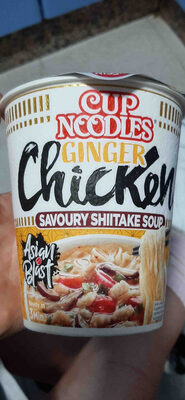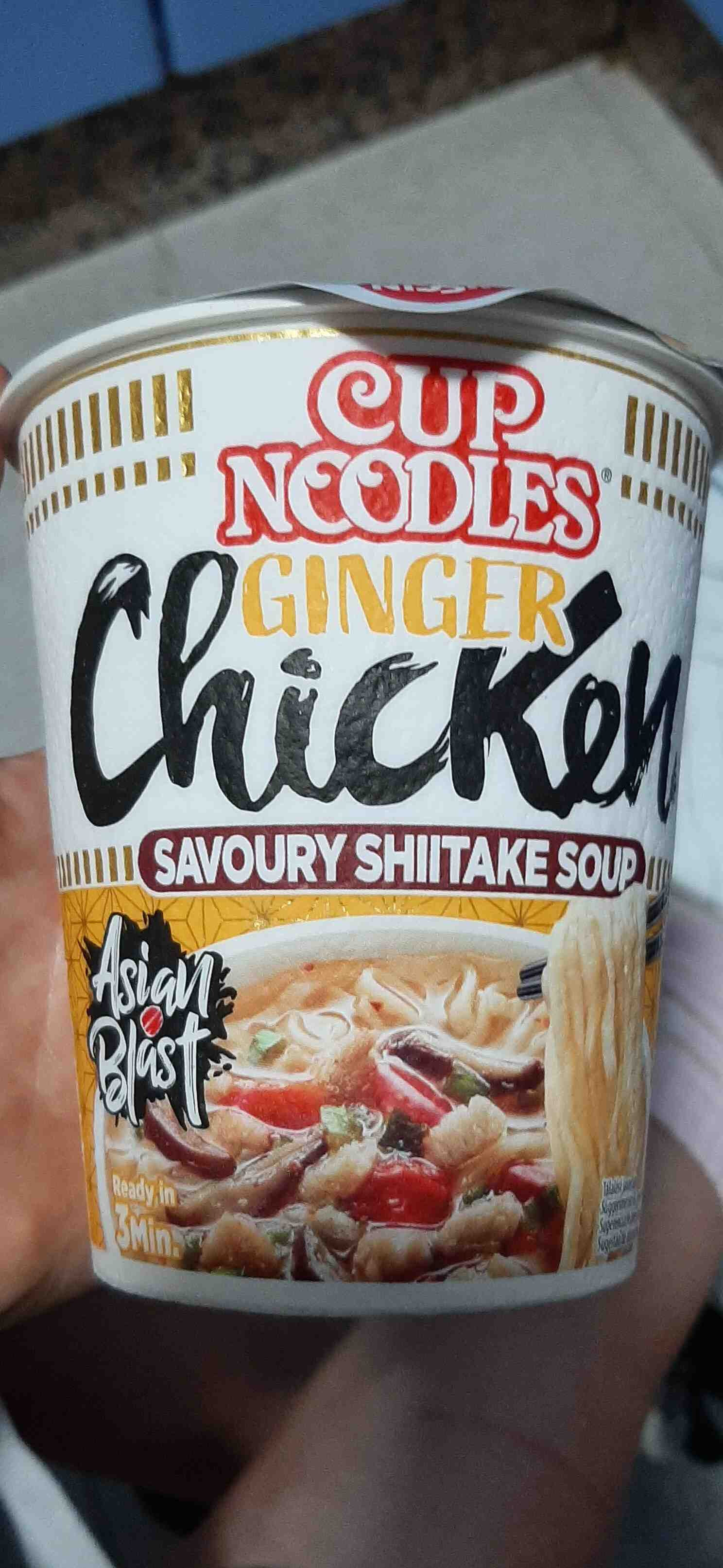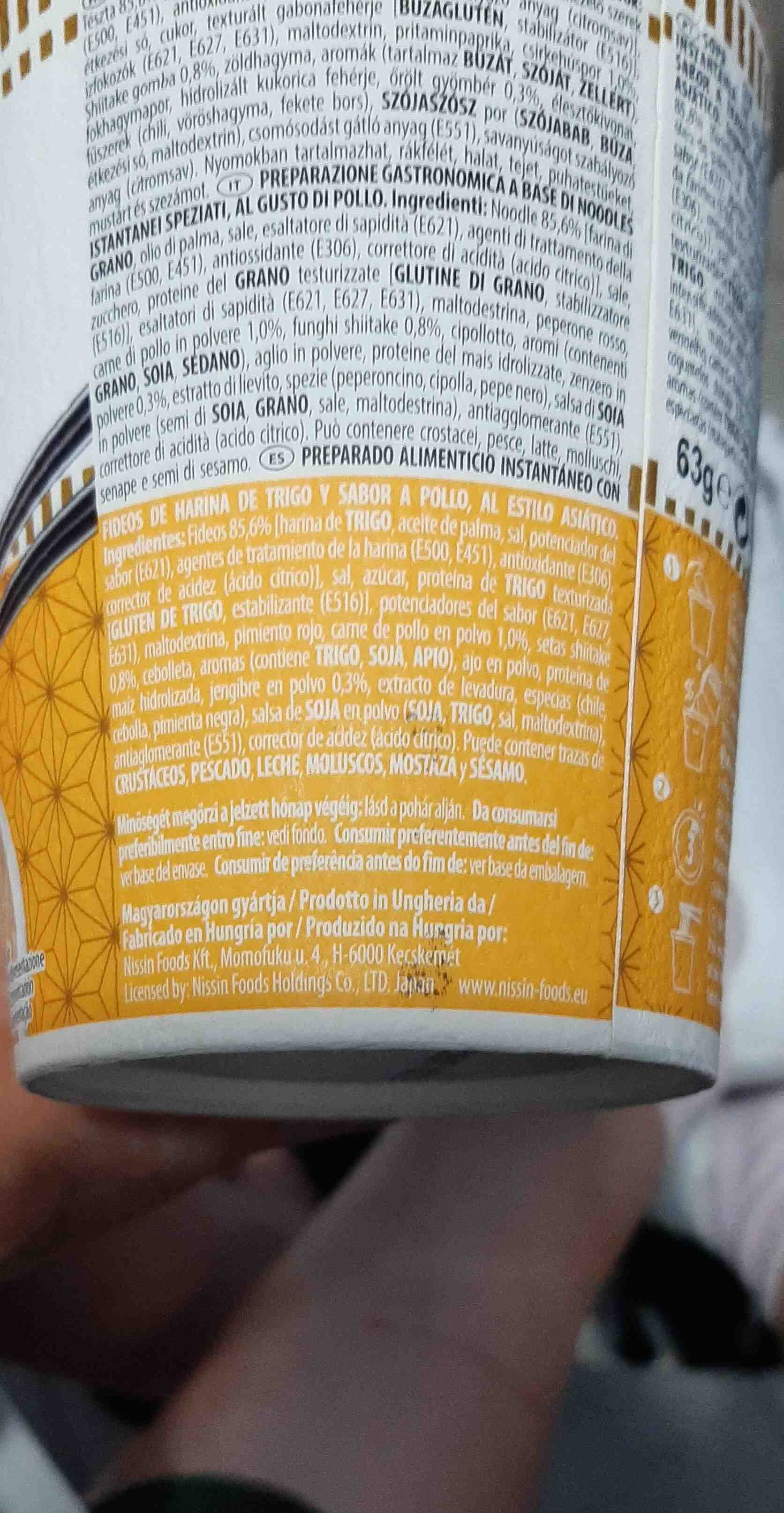Help us make food transparency the norm!
As a non-profit organization, we depend on your donations to continue informing consumers around the world about what they eat.
The food revolution starts with you!
Tasty Chicken Asian Style Soup
Tasty Chicken Asian Style Soup
This product page is not complete. You can help to complete it by editing it and adding more data from the photos we have, or by taking more photos using the app for Android or iPhone/iPad. Thank you!
×
Barcode: 5997523315009 (EAN / EAN-13)
Categories: Plant-based foods and beverages, Plant-based foods, Cereals and potatoes, Cereals and their products, Meals, Dried products, Pastas, Dried products to be rehydrated, Noodles, Soups, Dried meals, Instant noodles, Dehydrated soups
Countries where sold: Spain
Matching with your preferences
Health
Ingredients
-
45 ingredients
Romanian: Tăitel 85,6 % faină de grâu,ulei de palmier,sare, potenţiator de aroma E 621.agenti de tratare a făinil (E500, E451),antioxidant E306,corector de aciditate: acid citric), sare,zahar, proteina de grau texturata(gluten de grau, stabilizator E516)] potentiatori de gust((E621,E627.E631), sirop de glucoza, piper rosu pudra de carne de pui 1,0%, ciuperci shiitake 0,8%, ceapă verde, arome (contin grau, soia, telina).pudră de usturoi, proteina hidrolizată din porumb, pudră de ghimbir,extract de drojdie, condimente (ardel lute,ceapă, piper negru).pudra de sos de sola(sola boabe,grau,sare, maltodextrina), antiaglomerant (E551) regulator de aciditate(acid citric)Poate conține crustacee.peşte.lapte. moluşte,muştar şi susan.Allergens: Crustaceans, Gluten, SoybeansTraces: Milk
Food processing
-
Ultra processed foods
Elements that indicate the product is in the 4 - Ultra processed food and drink products group:
- Additive: E451 - Triphosphates
- Additive: E551 - Silicon dioxide
- Additive: E621 - Monosodium glutamate
- Additive: E627 - Disodium guanylate
- Ingredient: Flavouring
- Ingredient: Glucose
- Ingredient: Glucose syrup
- Ingredient: Gluten
- Ingredient: Maltodextrin
Food products are classified into 4 groups according to their degree of processing:
- Unprocessed or minimally processed foods
- Processed culinary ingredients
- Processed foods
- Ultra processed foods
The determination of the group is based on the category of the product and on the ingredients it contains.
Additives
-
E330 - Citric acid
Citric acid is a natural organic acid found in citrus fruits such as lemons, oranges, and limes.
It is widely used in the food industry as a flavor enhancer, acidulant, and preservative due to its tart and refreshing taste.
Citric acid is safe for consumption when used in moderation and is considered a generally recognized as safe (GRAS) food additive by regulatory agencies worldwide.
-
E451 - Triphosphates
Sodium triphosphate: Sodium triphosphate -STP-, also sodium tripolyphosphate -STPP-, or tripolyphosphate -TPP-,- is an inorganic compound with formula Na5P3O10. It is the sodium salt of the polyphosphate penta-anion, which is the conjugate base of triphosphoric acid. It is produced on a large scale as a component of many domestic and industrial products, especially detergents. Environmental problems associated with eutrophication are attributed to its widespread use.Source: Wikipedia
-
E500 - Sodium carbonates
Sodium carbonates (E500) are compounds commonly used in food preparation as leavening agents, helping baked goods rise by releasing carbon dioxide when they interact with acids.
Often found in baking soda, they regulate the pH of food, preventing it from becoming too acidic or too alkaline. In the culinary world, sodium carbonates can also enhance the texture and structure of foods, such as noodles, by modifying the gluten network.
Generally recognized as safe, sodium carbonates are non-toxic when consumed in typical amounts found in food.
-
E516 - Calcium sulphate
Calcium sulfate: Calcium sulfate -or calcium sulphate- is the inorganic compound with the formula CaSO4 and related hydrates. In the form of γ-anhydrite -the anhydrous form-, it is used as a desiccant. One particular hydrate is better known as plaster of Paris, and another occurs naturally as the mineral gypsum. It has many uses in industry. All forms are white solids that are poorly soluble in water. Calcium sulfate causes permanent hardness in water.Source: Wikipedia
-
E551 - Silicon dioxide
Silicon dioxide: Silicon dioxide, also known as silica, silicic acid or silicic acid anydride is an oxide of silicon with the chemical formula SiO2, most commonly found in nature as quartz and in various living organisms. In many parts of the world, silica is the major constituent of sand. Silica is one of the most complex and most abundant families of materials, existing as a compound of several minerals and as synthetic product. Notable examples include fused quartz, fumed silica, silica gel, and aerogels. It is used in structural materials, microelectronics -as an electrical insulator-, and as components in the food and pharmaceutical industries. Inhaling finely divided crystalline silica is toxic and can lead to severe inflammation of the lung tissue, silicosis, bronchitis, lung cancer, and systemic autoimmune diseases, such as lupus and rheumatoid arthritis. Uptake of amorphous silicon dioxide, in high doses, leads to non-permanent short-term inflammation, where all effects heal.Source: Wikipedia
-
E621 - Monosodium glutamate
Monosodium glutamate: Monosodium glutamate -MSG, also known as sodium glutamate- is the sodium salt of glutamic acid, one of the most abundant naturally occurring non-essential amino acids. Glutamic acid is found naturally in tomatoes, grapes, cheese, mushrooms and other foods.MSG is used in the food industry as a flavor enhancer with an umami taste that intensifies the meaty, savory flavor of food, as naturally occurring glutamate does in foods such as stews and meat soups. It was first prepared in 1908 by Japanese biochemist Kikunae Ikeda, who was trying to isolate and duplicate the savory taste of kombu, an edible seaweed used as a base for many Japanese soups. MSG as a flavor enhancer balances, blends, and rounds the perception of other tastes.The U.S. Food and Drug Administration has given MSG its generally recognized as safe -GRAS- designation. A popular belief is that large doses of MSG can cause headaches and other feelings of discomfort, known as "Chinese restaurant syndrome," but double-blind tests fail to find evidence of such a reaction. The European Union classifies it as a food additive permitted in certain foods and subject to quantitative limits. MSG has the HS code 29224220 and the E number E621.Source: Wikipedia
-
E627 - Disodium guanylate
Disodium guanylate: Disodium guanylate, also known as sodium 5'-guanylate and disodium 5'-guanylate, is a natural sodium salt of the flavor enhancing nucleotide guanosine monophosphate -GMP-. Disodium guanylate is a food additive with the E number E627. It is commonly used in conjunction with glutamic acid. As it is a fairly expensive additive, it is not used independently of glutamic acid; if disodium guanylate is present in a list of ingredients but MSG does not appear to be, it is likely that glutamic acid is provided as part of another ingredient such as a processed soy protein complex. It is often added to foods in conjunction with disodium inosinate; the combination is known as disodium 5'-ribonucleotides. Disodium guanylate is produced from dried seaweed and is often added to instant noodles, potato chips and other snacks, savory rice, tinned vegetables, cured meats, and packaged soup.Source: Wikipedia
Ingredients analysis
-
Palm oil
Ingredients that contain palm oil: Palm oil
-
Vegan status unknown
Unrecognized ingredients: ro:tăitel-85-6-faină-de-grâu, ro:potenţiator-de-aroma-e621-agenti-de-tratare-a-făinil, ro:proteina-de-grau-texturata, ro:potentiatori-de-gust, ro:e627-e631, ro:piper-rosu-pudra-de-carne-de-pui, ro:ciuperci-shiitake, ro:ceapă-verde, ro:telina, ro:proteina-hidrolizată-din-porumb, ro:ardel-lute, ro:pudra-de-sos-de-sola, ro:sola-boabe, ro:peşte-lapte, ro:moluşte, ro:muştar-şi-susanSome ingredients could not be recognized.
We need your help!
You can help us recognize more ingredients and better analyze the list of ingredients for this product and others:
- Edit this product page to correct spelling mistakes in the ingredients list, and/or to remove ingredients in other languages and sentences that are not related to the ingredients.
- Add new entries, synonyms or translations to our multilingual lists of ingredients, ingredient processing methods, and labels.
If you would like to help, join the #ingredients channel on our Slack discussion space and/or learn about ingredients analysis on our wiki. Thank you!
-
Vegetarian status unknown
Unrecognized ingredients: ro:tăitel-85-6-faină-de-grâu, ro:potenţiator-de-aroma-e621-agenti-de-tratare-a-făinil, ro:proteina-de-grau-texturata, ro:potentiatori-de-gust, ro:e627-e631, ro:piper-rosu-pudra-de-carne-de-pui, ro:ciuperci-shiitake, ro:ceapă-verde, ro:telina, ro:proteina-hidrolizată-din-porumb, ro:ardel-lute, ro:pudra-de-sos-de-sola, ro:sola-boabe, ro:peşte-lapte, ro:moluşte, ro:muştar-şi-susanSome ingredients could not be recognized.
We need your help!
You can help us recognize more ingredients and better analyze the list of ingredients for this product and others:
- Edit this product page to correct spelling mistakes in the ingredients list, and/or to remove ingredients in other languages and sentences that are not related to the ingredients.
- Add new entries, synonyms or translations to our multilingual lists of ingredients, ingredient processing methods, and labels.
If you would like to help, join the #ingredients channel on our Slack discussion space and/or learn about ingredients analysis on our wiki. Thank you!
-
Details of the analysis of the ingredients
We need your help!
Some ingredients could not be recognized.
We need your help!
You can help us recognize more ingredients and better analyze the list of ingredients for this product and others:
- Edit this product page to correct spelling mistakes in the ingredients list, and/or to remove ingredients in other languages and sentences that are not related to the ingredients.
- Add new entries, synonyms or translations to our multilingual lists of ingredients, ingredient processing methods, and labels.
If you would like to help, join the #ingredients channel on our Slack discussion space and/or learn about ingredients analysis on our wiki. Thank you!
ro: Tăitel 85.6% faină de grâu, ulei de palmier, sare, potenţiator de aroma e621.agenti de tratare a făinil (e500, e451), antioxidant (e306), corector de aciditate (acid citric), sare, zahar, proteina de grau texturata (gluten de grau, stabilizator (e516)), potentiatori de gust (e621, e627.e631), sirop de glucoza, piper rosu pudra de carne de pui 1%, ciuperci shiitake 0.8%, ceapă verde, arome (telina), usturoi, proteina hidrolizată din porumb, ghimbir, extract de drojdie, condimente (ardel lute, ceapă, piper negru), pudra de sos de sola (sola boabe, grau, sare, maltodextrina), antiaglomerant (e551), regulator de aciditate (acid citric), peşte.lapte, moluşte, muştar şi susan- Tăitel 85.6% faină de grâu -> ro:tăitel-85-6-faină-de-grâu
- ulei de palmier -> en:palm-oil - vegan: yes - vegetarian: yes - from_palm_oil: yes - ciqual_food_code: 16129
- sare -> en:salt - vegan: yes - vegetarian: yes - ciqual_food_code: 11058
- potenţiator de aroma e621.agenti de tratare a făinil -> ro:potenţiator-de-aroma-e621-agenti-de-tratare-a-făinil
- e500 -> en:e500 - vegan: yes - vegetarian: yes
- e451 -> en:e451 - vegan: yes - vegetarian: yes
- antioxidant -> en:antioxidant
- e306 -> en:e306 - vegan: yes - vegetarian: yes
- corector de aciditate -> en:acidity-regulator
- acid citric -> en:e330 - vegan: yes - vegetarian: yes
- sare -> en:salt - vegan: yes - vegetarian: yes - ciqual_food_code: 11058
- zahar -> en:sugar - vegan: yes - vegetarian: yes - ciqual_proxy_food_code: 31016
- proteina de grau texturata -> ro:proteina-de-grau-texturata
- gluten de grau -> en:wheat-gluten - vegan: yes - vegetarian: yes
- stabilizator -> en:stabiliser
- e516 -> en:e516 - vegan: yes - vegetarian: yes
- potentiatori de gust -> ro:potentiatori-de-gust
- e621 -> en:e621 - vegan: yes - vegetarian: yes
- e627.e631 -> ro:e627-e631
- sirop de glucoza -> en:glucose-syrup - vegan: yes - vegetarian: yes - ciqual_proxy_food_code: 31016
- piper rosu pudra de carne de pui -> ro:piper-rosu-pudra-de-carne-de-pui - percent: 1
- ciuperci shiitake -> ro:ciuperci-shiitake - percent: 0.8
- ceapă verde -> ro:ceapă-verde
- arome -> en:flavouring - vegan: maybe - vegetarian: maybe
- telina -> ro:telina
- usturoi -> en:garlic - vegan: yes - vegetarian: yes - ciqual_food_code: 11000
- proteina hidrolizată din porumb -> ro:proteina-hidrolizată-din-porumb
- ghimbir -> en:ginger - vegan: yes - vegetarian: yes - ciqual_food_code: 11074
- extract de drojdie -> en:yeast-extract - vegan: yes - vegetarian: yes - ciqual_proxy_food_code: 11009
- condimente -> en:condiment - vegan: maybe - vegetarian: maybe
- ardel lute -> ro:ardel-lute
- ceapă -> en:onion - vegan: yes - vegetarian: yes - ciqual_food_code: 20034
- piper negru -> en:black-pepper - vegan: yes - vegetarian: yes - ciqual_food_code: 11015
- pudra de sos de sola -> ro:pudra-de-sos-de-sola
- sola boabe -> ro:sola-boabe
- grau -> en:wheat - vegan: yes - vegetarian: yes - ciqual_proxy_food_code: 9410
- sare -> en:salt - vegan: yes - vegetarian: yes - ciqual_food_code: 11058
- maltodextrina -> en:maltodextrin - vegan: yes - vegetarian: yes
- antiaglomerant -> en:anti-caking-agent
- e551 -> en:e551 - vegan: yes - vegetarian: yes
- regulator de aciditate -> en:acidity-regulator
- acid citric -> en:e330 - vegan: yes - vegetarian: yes
- peşte.lapte -> ro:peşte-lapte
- moluşte -> ro:moluşte
- muştar şi susan -> ro:muştar-şi-susan
-
Nutrition facts
Nutrition facts As sold
for 100 g / 100 mlCompared to: Dehydrated soups Energy 338 kj
(81 kcal)-47% Fat 3.5 g +9% Saturated fat 1.9 g +61% Carbohydrates 9.6 g -60% Sugars 0.8 g -78% Fiber ? Proteins 2.1 g -50% Salt 1.1 g -67% Fruits‚ vegetables‚ nuts and rapeseed‚ walnut and olive oils (estimate from ingredients list analysis) 0 %
Environment
-
Eco-Score C - Moderate environmental impact
⚠ ️Select a country in order to include the full impact of transportation.The Eco-Score is an experimental score that summarizes the environmental impacts of food products.→ The Eco-Score was initially developped for France and it is being extended to other European countries. The Eco-Score formula is subject to change as it is regularly improved to make it more precise and better suited to each country.Life cycle analysis
-
Average impact of products of the same category: A (Score: 82/100)
Category: Asian noodles, flavoured, dehydrated
Category: Asian noodles, flavoured, dehydrated
- PEF environmental score: 0.26 (the lower the score, the lower the impact)
- including impact on climate change: 1.66 kg CO2 eq/kg of product
Stage Impact Agriculture
65.2 %Processing
20.8 %Packaging
8.7 %Transportation
3.5 %Distribution
1.8 %Consumption
0.0 %
Bonuses and maluses
-
Missing origins of ingredients information
Malus: -5
⚠ ️ The origins of the ingredients of this product are not indicated.
If they are indicated on the packaging, you can modify the product sheet and add them.
If you are the manufacturer of this product, you can send us the information with our free platform for producers.
-
Ingredients that threatens species
Malus: -10
Contains palm oil
Tropical forests in Asia, Africa and Latin America are destroyed to create and expand oil palm tree plantations. The deforestation contributes to climate change, and it endangers species such as the orangutan, the pigmy elephant and the Sumatran rhino.
-
Missing packaging information for this product
Malus: -15
⚠ ️ The information about the packaging of this product is not filled in.⚠ ️ For a more precise calculation of the Eco-Score, you can modify the product page and add them.
If you are the manufacturer of this product, you can send us the information with our free platform for producers.
Eco-Score for this product
-
Impact for this product: C (Score: 52/100)
Product: Tasty Chicken Asian Style Soup
Life cycle analysis score: 82
Sum of bonuses and maluses: -30
Final score: 52/100
-
Carbon footprint
-
Equal to driving 0.9 km in a petrol car
166 g CO² per 100g of product
The carbon emission figure comes from ADEME's Agribalyse database, for the category: Asian noodles, flavoured, dehydrated (Source: ADEME Agribalyse Database)
Stage Impact Agriculture
60.9 %Processing
14.9 %Packaging
16.3 %Transportation
6.9 %Distribution
1.0 %Consumption
0.0 %
Packaging
-
Missing packaging information for this product
⚠ ️ The information about the packaging of this product is not filled in.Take a photo of the recycling information Take a photo of the recycling information
Transportation
-
Origins of ingredients
Missing origins of ingredients information
⚠ ️ The origins of the ingredients of this product are not indicated.
If they are indicated on the packaging, you can modify the product sheet and add them.
If you are the manufacturer of this product, you can send us the information with our free platform for producers.Add the origins of ingredients for this product Add the origins of ingredients for this product
Threatened species
-
Contains palm oil
Drives deforestation and threatens species such as the orangutan
Tropical forests in Asia, Africa and Latin America are destroyed to create and expand oil palm tree plantations. The deforestation contributes to climate change, and it endangers species such as the orangutan, the pigmy elephant and the Sumatran rhino.
Report a problem
-
Incomplete or incorrect information?
Category, labels, ingredients, allergens, nutritional information, photos etc.
If the information does not match the information on the packaging, please complete or correct it. Open Food Facts is a collaborative database, and every contribution is useful for all.
Data sources
Product added on by elcoco
Last edit of product page on by ingriddd789.
Product page also edited by kiliweb, openfoodfacts-contributors, teolemon, veganeamos, yuka.sY2b0xO6T85zoF3NwEKvlmV3eeTMoSPbFBvmq267nvqqLrGyevBg5aGhPKs, yuka.sY2b0xO6T85zoF3NwEKvlmVsbMvh_GjjOhn5lRW3443Ucbfafo9y-bnrMqs.






